| 23 September |
• yesterday • tomorrow |
| Memorial of Saint Pius of Pietrelcina, Priest |
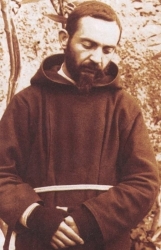
• Francesco Forgione
• Padre Pio of Pietrelcina
• Pio of Pietrelcina
Born to a southern Italian farm family, the son of Grazio, a shepherd. At age 15 he entered the novitiate of the Capuchin friars in Morcone, Italy and joined the order at age 19. Suffered several health problems, and at one point his family thought he had tuberculosis. Ordained at age 22 on 10 August 1910.
While praying before a cross, he received the stigmata on 20 September 1918, the first priest ever to be so blessed. As word spread, especially after American soldiers brought home stories of Padre Pio following WWII, the priest himself became a point of pilgrimage for both the pious and the curious. He would hear confessions by the hour, reportedly able to read the consciences of those who held back. Reportedly able to bilocate, levitate, and heal by touch. Founded the House for the Relief of Suffering in 1956, a hospital that serves 60,000 a year. In the 1920's he started a series of prayer groups that continue today with over 400,000 members worldwide.
His canonization miracle involved the cure of Matteo Pio Colella, age 7, the son of a doctor who works in the House for Relief of Suffering, the hospital in San Giovanni Rotondo founded by Padre Pio. On the night of 20 June 2000, Matteo was admitted to the intensive care unit of the hospital with meningitis. By morning, doctors had lost hope for him as nine of the boy's internal organs had ceased to give signs of life. That night, during a prayer vigil attended by Matteo's mother and some Capuchin friars of Padre Pio's monastery, the child's condition improved suddenly. When he awoke from the coma, Matteo said that he had seen an elderly man with a white beard and a long, brown habit, who said to him: "Don't worry, you will soon be cured." The miracle was approved by the Congregation and Pope John Paul II on 20 December 2001.
25 May 1887 at Pietrelcina, Benevento, Italy as Francesco Forgione
23 September 1968 in San Giovanni Rotondo, Foggia, Italy of natural causes
16 June 2002 by Pope John Paul II at Rome, Italy
Look what fame he had, what a worldwide following gathered around him! But why? Perhaps because he was a philosopher? Because he was wise? Because he had resources at his disposal? Because he said Mass humbly, heard confessions from dawn to dusk and was-it is not easy to say it-one who bore the wounds of our Lord. He was a man of prayer and suffering. - Pope Paul VI, 21 Febuary 1971, commenting on the life of Padre Pio
And you, Blessed Padre Pio, look down from heaven upon us assembled in this square and upon all gathered in prayer before the Basilica of Saint John Lateran and in San Giovanni Rotondo. Intercede for all those who, in every part of the world, are spiritually united with this event and raise their prayers to you. Come to the help of everyone; give peace and consolation to every heart. Amen! - from the homily of Pope John Paul II at the beatification of Padre Pio
Stay with me, Lord, for it is necessary to have You present so that I do not forget You. You know how easily I abandon You. Stay with me, Lord, because I am weak and I need Your strength, that I may not fall so often. Stay with me, Lord, for You are my life and without You I am without fervor. Stay with me, Lord, for You are my light and without You I am in darkness. Stay with me, Lord, to show me Your will. Stay with me, Lord, so that I hear Your voice and follow You. Stay with me, Lord, for I desire to love You very much and alway be in Your company. Stay with me, Lord, if You wish me to be faithful to You. Stay with me, Lord, as poor as my soul is I want it to be a place of consolation for You, a nest of Love. Stay with me, Jesus, for it is getting late and the day is coming to a close and life passes, death, judgment and eternity approaches. It is necessary to renew my strength, so that I will not stop along the way and for that, I need You. It is getting late and death approaches, I fear the darkness, the temptations, the dryness, the cross, the sorrows. O how I need You, my Jesus, in this night of exile! Stay with me tonight, Jesus, in life with all its dangers, I need You. Let me recognize You as Your disciples did at the breaking of the bread, so that the Eucharistic Communion be the Light which disperses the darkness, the force which sustains me, the unique joy of my heart. Stay with me, Lord, because at the hour of my death, I want to remain united to You, if not by Communion, at least by grace and love. Stay with me, Lord, for it is You alone I look for, Your Love, Your Grace, Your Will, Your Heart, Your Spirit, because I love You and ask no other reward but to love You more and more. With a firm love, I will love You with all my heart while on earth and continue to love You perfectly during all eternity. Amen. - Padre Pio's Prayer After Holy Communion
https://catholicsaints.info/saint-padre-pio/
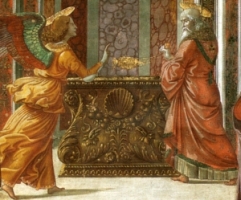
Zaccaria, Zacharias, Zachary, Zakariya
Jewish priest in Jerusalem. Married to Saint Elizabeth; father of Saint John the Baptist. In his later years he was visited in the temple by the angel Gabriel who explained that Zechariah and Elizabeth would have a son. When he replied that they were too old for such a thing he was struck mute for his doubts; his speech was restored after John's birth, and a canticle he spoke is recorded in the Gospel of Luke.
one tradition says he was murdered in the Temple when he refused to tell Herod where his son John could be found
In the days of Herod, King of Judea, there was a priest named Zechariah of the priestly division of Abijah; his wife was from the daughters of Aaron, and her name was Elizabeth. Both were righteous in the eyes of God, observing all the commandments and ordinances of the Lord blamelessly. But they had no child, because Elizabeth was barren and both were advanced in years.
Once when he was serving as priest in his division's turn before God, according to the practice of the priestly service, he was chosen by lot to enter the sanctuary of the Lord to burn incense. Then, when the whole assembly of the people was praying outside at the hour of the incense offering, the angel of the Lord appeared to him, standing at the right of the altar of incense. Zechariah was troubled by what he saw, and fear came upon him. But the angel said to him, "Do not be afraid, Zechariah, because your prayer has been heard. Your wife Elizabeth will bear you a son, and you shall name him John. And you will have joy and gladness, and many will rejoice at his birth, for he will be great in the sight of [the] Lord. He will drink neither wine nor strong drink. He will be filled with the holy Spirit even from his mother's womb, and he will turn many of the children of Israel to the Lord their God. He will go before him in the spirit and power of Elijah to turn the hearts of fathers toward children and the disobedient to the understanding of the righteous, to prepare a people fit for the Lord."
Then Zechariah said to the angel, "How shall I know this? For I am an old man, and my wife is advanced in years."
And the angel said to him in reply, "I am Gabriel, who stand before God. I was sent to speak to you and to announce to you this good news. But now you will be speechless and unable to talk until the day these things take place, because you did not believe my words, which will be fulfilled at their proper time."
Meanwhile the people were waiting for Zechariah and were amazed that he stayed so long in the sanctuary. But when he came out, he was unable to speak to them, and they realized that he had seen a vision in the sanctuary. He was gesturing to them but remained mute. Then, when his days of ministry were completed, he went home.
-
When the time arrived for Elizabeth to have her child she gave birth to a son. Her neighbors and relatives heard that the Lord had shown his great mercy toward her, and they rejoiced with her. When they came on the eighth day to circumcise the child, they were going to call him Zechariah after his father, but his mother said in reply, "No. He will be called John."
But they answered her, "There is no one among your relatives who has this name."
So they made signs, asking his father what he wished him to be called. He asked for a tablet and wrote, "John is his name," and all were amazed. Immediately his mouth was opened, his tongue freed, and he spoke blessing God.
-
Then Zechariah his father, filled with the holy Spirit, prophesied, saying:
"Blessed be the Lord, the God of Israel,
for he has visited and brought redemption to his people.
He has raised up a horn for our salvation
within the house of David his servant,
even as he promised through the mouth of his holy prophets from of old:
salvation from our enemies and from the hand of all who hate us,
to show mercy to our fathers
and to be mindful of his holy covenant,
and of the oath he swore to Abraham our father,
and to grant us that,
rescued from the hand of enemies,
without fear we might worship him
in holiness and righteousness
before him all our days.
And you, child, will be called prophet of the Most High,
for you will go before the Lord to prepare his ways,
to give his people knowledge of salvation
through the forgiveness of their sins,
because of the tender mercy of our Gods
by which the daybreak from on high will visit us
to shine on those who sit in darkness and death's shadow,
to guide our feet into the path of peace."
- Luke 1:5-23; 57-64; 67-79
https://catholicsaints.info/saint-zechariah/

émilie Tavernier
Daughter of Antoine Tavernier and Marie-Josephte Maurice, the youngest of 15 children. Orphaned young, and raised by her aunts. Educated by the Sisters of the Congregation of Notre Dame at the Saint-Jean-Baptiste Street school. Felt drawn from an early age to work with the poor and disadvantaged; when her brother was widowed, the 18 year old Emilie went to help him on one condition - their table would always be open to the hungry who came to the door.
Married Jean-Baptiste Gamelin, a wealthy and pious apple farmer, on 4 June 1823. Mother of three sons, all of whom died as children. Widowed on 1 October 1827. Took Mary, Mother of Sorrows, as her guide for dealing with these losses, and during her time in prayer, she came to see all the poor and needy as her new family. She turned her home and inheritance into a shelter for the poor, for orphaned, abandoned or runaway children, the mentally ill, homeless, handicapped, immigrants, and destitute of any form. People began to refer to her home as the House of Providence, and she was soon after to find other residences to help and become such Houses. She worked with prisoners, and cared for the sick, brought in her family and friends to help, and led by her example. For fifteen years she worked on her own, always submitting her ideas to her priest and bishop, and completely obedient to them.
In 1841, Bishop Bourget asked the Daughters of Saint Vincent de Paul to send sisters to help Emilie; the congregation agreed, but last minute problems prevented the sisters from leaving Paris. Seeing no outside help available, the bishop then called upon the faithful in his diocese, and Canadian lay women soon presented themselves to help. From this group, under Emilie leadership and by her example, the Sisters of Providence were formed in Montreal. The congregation's first vows were made on 29 March 1844 with Emilie as novice, nun, foundress and Mother Superior.
The new community faced many early trials. There were always problems of funds and resoures, disease thinned their ranks, and internal dissent threatened to lose Emilie the support of her bishop. But the group survived. There were 50 sisters at the time of Emilie's death, less than eight years after the group's formation. Over 6,000 Sisters have joined the order over the years, today working in Canada, the United States, Chile, Argentina, Haiti, Cameroo, Egypt, the Philippines and El Salvador. At her beatification recognition, Pope John Paul II presented her as a model for all by her life dedicated to the most needy.
19 February 1800 at Montreal, Canada
23 September 1851 of cholera at Montreal, Canada
• 7 October 2001 by Pope John Paul II
• the beatification miracle involved the cure of a fatally ill 13-year-old on 18 December 2000
Humility, simplicity, charity, but above all charity. - Blessed Emilie's dying words
The new Blessed is a model for the men and women of today. Blessed Emilie's spiritual life gave her strength for her charitable mission; she emptied herself of all things and found the energy to comfort everyone. Taking her as your model, I encourage you to put yourselves at the service of the poor and of society's most underprivileged who are God's beloved, to alleviate their sufferings and thus make their dignity shine out. - Pope John Paul II during the beatification ceremony for Blessed Emilie
https://catholicsaints.info/blessed-emilie-tavernier-gamelin/
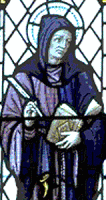
Adam, Adamnano, Adomnan, Eunan
Distant relative of Saint Columba. Monk at Drunhome, Donegal, Ireland. Abbot of Iona in 679. President-general of all the Columban houses in Ireland. Evangelized throughout Ireland.
Adamnan gave sanctuary to Prince Aldfrid when the throne of Northumbria was in dispute following the death of King Oswy. When Aldfrid became king in 686, Aldamnan secured the release of all Irish prisoners taken in the conflict, and visited the monasteries of Wearmouth and Jarrow.
Persuaded by Saint Ceolfrid, Adamnan adopted the Roman calendar for determining Easter, and then worked for the adoption of many Roman liturgical practices in the Celtic region. This so displeased some brother monks at Iona that from 692 on, Adamnan rarely went there.
Attended the Council of Birr and Synod of Tara in 697 at which he helped enact the Canons of Adamnan, laws that helped protect civilian and clerical populations in areas at war, prohibiting the murder or enslavement of non-combatant women and children. A noted scholar, he wrote the biography Life of Saint Columba in the late 680's, a work that survives today (see links below). He also wrote De locis sanctis (On the Holy Places), a popular description of Palestine based on the notes of and interviews with the Frankish pilgrim bishop Arculf. Renovated and revitalized the monastery of Raphoe, Ireland.
c.628 in Drumhome, County Donegal, Ireland
• 23 September 704 at Iona Abbey
• relics taken to various Irish sites during the next century during peacemaking conferences
• most relics were destroyed during Danish incursions in 830 and 1030
• Pre-Congregation
• 11 July 1898 by Pope Leo XIII (cultus confirmed)
• Donegal, Ireland, county of
• Raphoe, Ireland, city of
• Raphoe, Ireland, diocese of
• man in prayer with the moon and seven stars over his head
• man writing (his biography of Saint Columba)
Life of Saint Columba
• Books
https://catholicsaints.info/saint-adamnan-of-iona/
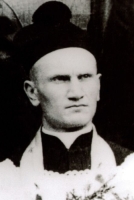
12 June as one of the 108 Martyrs of World War II
Baptized at the age of one day, Jozef was orphaned at age six. He was educated at a Pallottine school in Wadowice, Poland, and in 1935 at age 18, he became a Pallottine novice. Ordained a priest on 7 April 1941, he started his three year ministry in a Poland that was under Nazi occupation and in the middle of World War II. At the beginning of the Warsaw Uprising on 1 August 1944, Father Jozef served as chaplain to the insurgents, staying in the combat areas to care for and bring the sacraments to those fighting and those who were trapped in the city; given a chance to escape the city, he gave up his seat to an injured man. On 22 September 1944, he went to the Nazi authorities to try to negotiate a settlement and save as many lives as possible. Instead of working with him, the Nazis captured, beat and murdered him for being a priest. Martyr.
4 December 1916 in Lapsze Nizne, Poland
• hanged on 23 September 1944 in a ruined factory in the Solec district of Czerniaków, Poland
• body left to hang as an example to others
• the chapel in the Warsaw Uprising Museum is named in his honour
13 June 1999 by Pope John Paul II in Warsaw, Poland
https://catholicsaints.info/blessed-jozef-stanek/
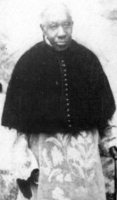
Born a slave and trained as a tailor. He early felt a call to the priesthood, but, being a slave, had to have special dispensation to enter seminary, and was shunned by fellow seminarians and the parishioners of his first assignment in the diocese of Campanha, Brazil; his parishioners even refused to accept Communion from his hands. He persevered in his vocation, always patient, always forgiving, always dedicated to the faith and the priesthood, and eventually won the people over to the point that there were protests when the diocese considered transferring him to another parish.
12 April 1827 in Campanha, Minas Gerais, Brazil
23 September 1905 in Três Pontas, Minas Gerais, Brazil
• 14 November 2015 Pope Francis
• beatification celebrated at the parish of Nossa Senhora D'Ajuda, Três Pontas, Minas Gerais, Brazil, presided by Cardinal Angelo Amato
https://catholicsaints.info/blessed-francisco-de-paula-victor/
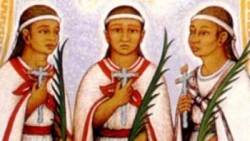
Anthony
Grandson of the Tlaxcala noble Xicohténcati, and heir to his title and estates. Convert to Christianity. One of the Three Child Martyrs of Tlaxcala.
c.1516-1517 in Tizatlán, Tlaxcala, Mexico
beaten to death with clubs in 1529 at Cuauhtinchán, Puebla, Mexico
6 May 1990 by Pope John Paul II
With great joy I have also proclaimed as Blessed the three child martyrs of Tlaxcala: Cristobal, Antonio and Juan. At a tender age they were drawn to the words and witness of the missionaries and they became helpers, as catechists for other indigenous people. They are sublime and instructive examples of how evangelization is a task of all God's People, excluding no one, not even children. With the Church in Tlaxcala and in Mexico, I am pleased to be able to offer all of Latin America and the universal Church this example of child-like piety, of apostolic and missionary generosity, crowned by the grace of martyrdom. - from the beatification homily of Pope John Paul II
https://catholicsaints.info/blessed-antonio-of-tlaxcala/
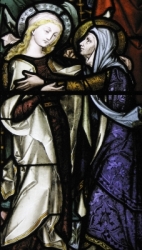
Descendant of the Old Testament patriarch, Aaron. Wife of Zachary, temple priest. Relative of Mary. Mother of Saint John the Baptist, becoming pregnant very late in life. She was the Elizabeth that Mary visited soon after the Annunciation. Described in the Gospel of Luke as "righteous in the eyes of God, observing all the commandments and ordinances of the Lord blamelessly."
1st century BC
1st century AD of natural causes
• expectant mothers, pregnant women
• diocese of Fulda, Germany
• elderly woman holding the infant John the Baptist
• pregnant woman with the Virgin Mary
• in company of Saint Zachary
https://catholicsaints.info/saint-elizabeth/
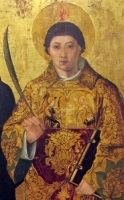
• Sosius of Miseno
• Sosius of Puzzuoli
• Sosier, Sosio, Sosius, Sossio, Sossius, Sosso
Deacon of the church of Miseno, Italy. Imprisoned and martyred in the persecutions of Diocletian.
275 in Miseno, Italy
• beheaded on 19 September 305 at Pozzuoli, Campagna, Italy
• interred in Miseno, Italy
• Miseno was destroyed by invading Saracens; the survivors were transferred to Frattamaggiore, Italy, and chose Sosius as their patron
• relics later recovered from Miseno and taken to the Santi Severino e Sossio abbey in Naples, Italy
• abbey suppressed in the Napoleonic area, and the relics were transferred to the basilica of San Sosius in Frattamaggiore
• Frattamaggiore, Italy
• San Sossio Baronia, Italy
https://catholicsaints.info/saint-sosius-of-misenum/
Tecla, Tegla, Tekla
• Protomartyr among women and equal to the Apostles
First century convert in Iconium, brought to the faith by the preaching of Saint Paul the Apostle; her family threw her out. She dedicated herself to God, became a spiritual student of Saint Paul, and assisted him in his travels and works. She was thrown to wild animals as a Christian, but survived; she was sentenced to burn at the stake, but managed to escape. In her later years she retired to live as a hermitess. Because of her sufferings for the the faith, she is considered a martyr though she survived the attempts to kill her. She is mentioned the Prayers for the Dying. She was the subject several fantastic apochryphal writings in the early Church.
• late 1st century of natural causes
• buried in Seleucia, Pamphylia, Anatolia (in modern Turkey)
https://catholicsaints.info/saint-thecla-of-iconium/
Norberto joined the Franciscan Capuchin lay oblates in El Pardo, Madrid, Spain. He was serving there in 1936 at the start of the Spanish Civil War when the convent came under siege by hundreds of militiamen. Norberto managed to escape, and hid for a while in a local inn, but was located, arrested and executed for being in religious life. Martyr.
• 6 June 1891 in Villalquite, León, Spain
• as he was born on the feast day of Saint Norbert of Magdeburg, his parents named him Noberto
23 September 1936 in Madrid, Spain
• 13 October 2013 by Pope Francis
• beatification celebrated at the Complex Educatiu, Tarragona, Spain, presided by Cardinal Angelo Amato
https://catholicsaints.info/blessed-norberto-cembranos-de-la-verdura/
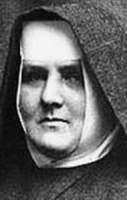
Raised in a pious family. Spiritual student of Saint Albert Chmielowski. Co-foundress of the Sisters of the Third Order of Saint Francis Servants of the Poor (Albertine Sisters). Known as a mystic with a great concern for those who are suffering. As superior of the Sisters she founded hospices for the sick and poor.
5 August 1878 in Pyzuny Lukawica, Poland
23 September 1940 in Krakow, Poland
6 June 1997 at Zakopane, Poland by Pope John Paul II
To give, eternally to give. - Blessed Bernardina
https://catholicsaints.info/blessed-bernardina-maria-jablonska/
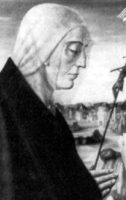
• Helen of Bologna
• Elena Duglioli Dall'Olio
Lay woman who, against her will, married Benedict dall'Oglio in order to please her family; she spent 30 happy years with him, both of them being known for their Christian lives. Widowed, she devoted herself to charity in her few remaining years. Those who knew her considered her a saint in life, a public cultus spontaneously developed, and even the future Pope Benedict XIV spoke for her beatification Cause.
1472 at Bologna, Italy
1520 of natural causes
1828 by Pope Leo XII (cultus confirmed)
https://catholicsaints.info/blessed-helen-duglioli/
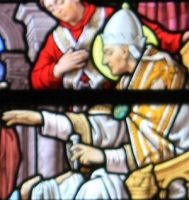
Second Pope, and the first to be chosen in Rome, Italy. According to Irenaeus, he is the Linus mentioned by Saint Paul in 2nd Timothy 4. His name is mentioned in the prayer "Communicantes" in the Canon of the Mass. Traditionally honoured as a martyr, though there is no certain documentation of this. Nothing else is known of his life, and ancient documents about his papacy have proven to be inaccurate or apocryphal.
in Tuscany, Italy
67
76 in Rome, Italy
https://catholicsaints.info/pope-saint-linus/
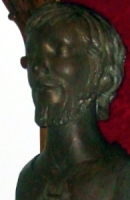
• William Flower
• William May
29 October as one of the Martyrs of Douai
Seminarian in Reims, France. Ordained in 1586. He returned to England to minister to covert Catholics, hiding under the name William Flowers. Imprisoned and executed for the crime of priesthood. Martyr.
Exeter, England
hanged, drawn and quartered on 23 September 1588 at Kingston-on-Thames, London, England
15 December 1929 by Pope Pius XI
https://catholicsaints.info/blessed-william-way/

Christopher, Cristobalito
Son of a pagan tribal chief. Convert to Christianity. Educated at the first Franciscan school in Tlaxcala. Beaten and then martyred by order of his father for refusing to deny his faith. One of the Three Child Martyrs of Tlaxcala.
c.1514-1515 in Atlihuetzía, Tlaxcala, Mexico
burned to death in 1527 at Tizatlán, Tlaxcala, Mexico
6 May 1990 by Pope John Paul II
https://catholicsaints.info/blessed-cristobal/

Servant of Blessed Antonio. Convert to Christianity. One of the Three Child Martyrs of Tlaxcala.
c.1516-1517 in Tizatlán, Tlaxcala, Mexico
beaten to death with clubs in 1529 at Cuauhtinchán, Puebla, Mexico
6 May 1990 by Pope John Paul II
https://catholicsaints.info/blessed-juan-of-tlaxcala/
Cistercian Benedictine monk at Clairvaux, and one of Saint Bernard of Clairvaux's most beloved disciples. Founder and abbot of the abbey of Our Lady of Cherlieu in the diocese of Besancon, France. At Saint Bernard's request, Guy revised the Cistercian liturgical chant.
c.1157 of natural causes
https://catholicsaints.info/blessed-guy-of-durnes/
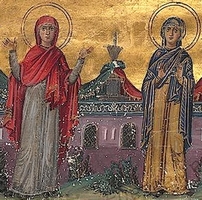
Xanthippe
Spiritual student of the Apostles.
late 1st century in Spain
https://catholicsaints.info/saint-xantippa/

Polyxene
Spiritual student of the Apostles.
late 1st century in Spain
https://catholicsaints.info/saint-polyxena/
Eighth-century spiritual student of Saint Guthlac and Benedictine hermit at Crowland Abbey in England.
https://catholicsaints.info/saint-cissa-of-northumbria/
Sixth century sacristan of the church of Saint Stephen, Ancona, Italy.
https://catholicsaints.info/saint-constantius-of-ancona/
Group of Christians deported from Syracuse, Sicily by invading Saracens and sent to North Africa where they were tortured and executed for their faith. Martyrs. The names that have survived are Andrew, Antony, John and Peter.
c.900
https://catholicsaints.info/martyrs-of-syracuse/
Thousands of people were murdered in the anti-Catholic persecutions of the Spanish Civil War from 1934 to 1939. I have pages on each of them, but in most cases I have only found very minimal information. They are available on the CatholicSaints.Info site through these links:
• Blessed Crispulo Moyano Linares
• Blessed José Santos Ortega
• Blessed María Josefa del Río Messa
• Blessed Norberto Cembranos de la Verdura
• Blessed Purificación Ximénez y Ximénez
• Blessed Sofía Ximénez y Ximénez del Río
• Blessed Vicente Ballester Far
• Ascension of San Joseph Calasanz Llored Marco
• Rebecca the Matriarch
CatholicSaints.Info Portable Edition